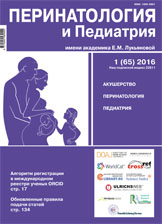Уникальный случай пренатальной диагностики синдрома Пьера Робена с клоническими судорогами у плода. Клинические аспекты
DOI:
https://doi.org/10.15574/PP.2016.65.68Аннотация
В работе приведены основные сведения о синдроме Пьера Робена как редкой генетической патологии с освещением специфических диагностических и клинических аспектов. Обоснована необходимость своевременной пренатальной и постнатальной диагностики для оценки тяжести состояния плода, новорожденного и ребёнка с вероятностью последующего адекватного лечения. Описаны два клинических случая: плода с синдромом Пьера Робена и пренатальными клоническими судорогами, а также пациента в возрасте двух лет с синдромом Пьера Робена и множественными структурными аномалиями центральной нервной системы. Определены особенно опасные проявления патологии, которые приводят к летальным исходам
.
Библиографические ссылки
Melnikova EV, Karachunskiy MG, Tamazyan GV i dr. 2008. Taktika vedeniya novorozhdennyih s sindromom Pera Robena. Voprosyi prakticheskoy pediatrii. 3; 5: 36—37.
Bronshtein M, Blazer S, Zalel Y, Zimmer EZ. 2005. Ultrasonographic diagnosis of glossoptosis in fetuses with Pierre Robin sequence in early and mid pregnancy. Am J Obstet Gynecol. 193: 1561—1564.
Van den Elzen AP, Semmerkrot BA, Bongers EM et al. 2001. Diagnosis and treatment Pierre Robin sequence: results of a retrospective clinical study and review of the literature. Eur J Pediatr. 160: 47—53.
Hong P, Brake MK, Cavanagh JP et al. 2012. Feeding and mandibular distraction osteogenesis in children with Pierre Robin sequence: A case series of functional outcomes. Int J Pediatr Otorhinolaryngol. 76(3): 414—418. http://dx.doi.org/10.1016/j.ijporl.2011.12.023; PMid:22245167
Gruen PM, Carranza A, Karmody CS. 2005. Anomalies of the ear in the Pierre Robin triad. Ann Otol Rhinol Laryngol. 114(8): 605—613.
Holder-Espinasse M. Abadie V., Cormier-Daire V. 2001. Pierre Robin sequence: a series of 117 consecutive cases. J Pediatr. 139: 588—590.
Hong P. 2011. A clinical narrative review of mandibular distraction osteogenesis in neonates with Pierre Robin sequence. Int J Pediatr Otorhinolaryngol. 75(8): 985—991. http://dx.doi.org/10.1016/j.ijporl.2011.05.003; PMid:21621862
Kam K, McKay M, MacLean J. 2015. Surgical versus nonsurgical interventions to relieve upper airway obstruction in children with Pierre Robin sequence. Can Respir J. 22(3): 171—175. http://dx.doi.org/10.1155/2015/798076; PMid:25848803 PMCid:PMC4470552
Lidsky ME, Lander TA, Sidman JD. 2008. Resolving feeding difficulties with early airway intervention in Pierre Robin Sequence. Laryngoscope. 118(1): 120—123.
Paladini D, Morra T, Teodoro A et al. 1999. Objective diagnosis of micrognathia in the fetus: the Jaw Index. Obstet Gynecol. 93: 382—386.
Paladini D. 2010. Fetal micrognathia: almost always anominous finding. Ultrasound Obstet Gynecol. 35: 377—384.
Rathe M, Rayyan M, Schoenaers J et al. 2015. Pierre Robin sequence: Management of respiratory and feeding complications during the first year of life in a tertiary referral centre. Int J Pediatr Otorhinolaryngol. 79(8): 1206—1212. http://dx.doi.org/10.1016/j.ijporl.2015.05.012; PMid:26092549
Pilu G, Romero R, Reece EA. 1986. The prenatal diagnosis of Robin anomaly. Am J Obstet Gynecol. 154: 630—632.
Soulier M, Sigaudy S, Chau C, Philip N. 2002. Prenatal diagnosis of Pierre-Robin sequence as part of Stickler syndrome. Prenat Diagn. 22(7): 567—568. http://dx.doi.org/10.1002/pd.369; PMid:12124689
Printzlau A, Andersen M. 2004. Pierre Robin sequence in Denmark: a retrospective population-based epidemiological study. Cleft Palate Craniofac J. 41(1): 47—52. http://dx.doi.org/10.1597/02-055; PMid:14697070
Evans AK, Rahbar R, Rogers GF et al. 2006. Robin sequence: a retrospective review of 115 patients. Int J Pediatr Otorhinolaryngol. 70(6): 973—980. http://dx.doi.org/10.1016/j.ijporl.2005.10.016; PMid:16443284
Evans KN, Sie KC, Hopper RA et al. 2011. Robin sequence: from diagnosis to development of an effective management plan. Рediatria. 127: 936—948.
Costa MA, Tu MM, Murage KP et al. 2014. Robin sequence: mortality, causes of death, and clinical outcomes. Plast Reconstr Surg. 134(4): 738—745.
">http://dx.doi.org/10.1097/prs.0000000000000510
Smith MC, Senders CW. 2006. Prognosis of airway obstruction and feeding difficulty in the Robin sequence. Int J Pediatr Otorhinolaryngol. 70(2): 319—324. http://dx.doi.org/10.1016/j.ijporl.2005.07.003; PMid:16112206
Teoh M, Meagher S. 2003. First-trimester diagnosis of micrognathia as a presentation of Pierre Robin syndrome. Ultrasound Obstet Gynecol. 21(6): 616—618. http://dx.doi.org/10.1002/uog.141; PMid:12808682
Rotten D, Levaillant JM, Martinez H et al. 2002. The fetal mandible: a 2D and 3D sonographic approach to the diagnosis of retrognathia and micrognathia. Ultrasound Obstet Gynecol. 19: 122-130.
Jakobsen LP, Knudsen MA, Lespinasse J et al. 2006. The genetic basis of the Pierre Robin Sequence. Cleft Palate Craniofac J. 43(2): 155—159. http://dx.doi.org/10.1597/05-008.1; PMid:16526920
Tibesar RJ, Price DL, Moore EJ. 2006. Mandibular distraction osteogenesis to relieve Pierre Robin airway obstruction. Am J Otolaryngol. 27(6): 436—439. http://dx.doi.org/10.1016/j.amjoto.2006.03.006; PMid:17084233
Wagener S, Rayatt SS, Tatman AJ. 2003. Management of infants with Pierre Robin sequence. Cleft Palate Craniofac J. 40(2): 180—185. http://dx.doi.org/10.1597/1545-1569(2003)040<0180:MOIWPR>2.0.CO;2

